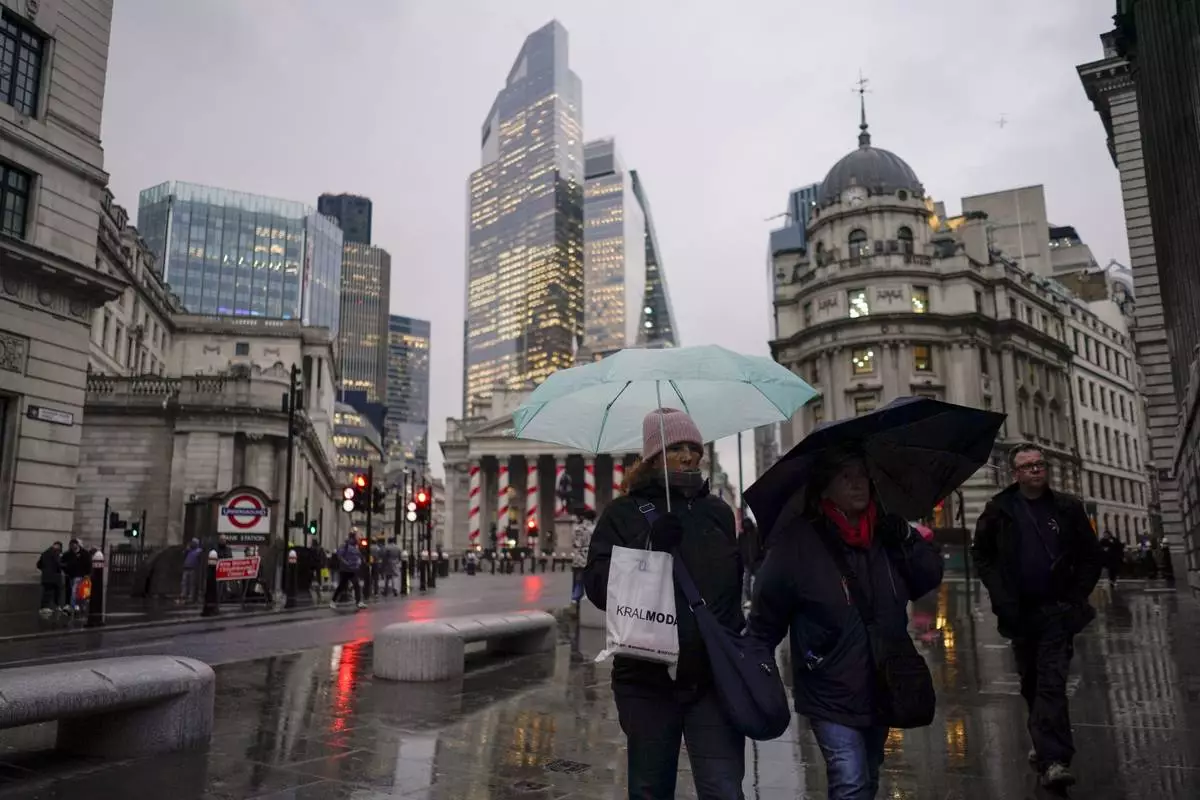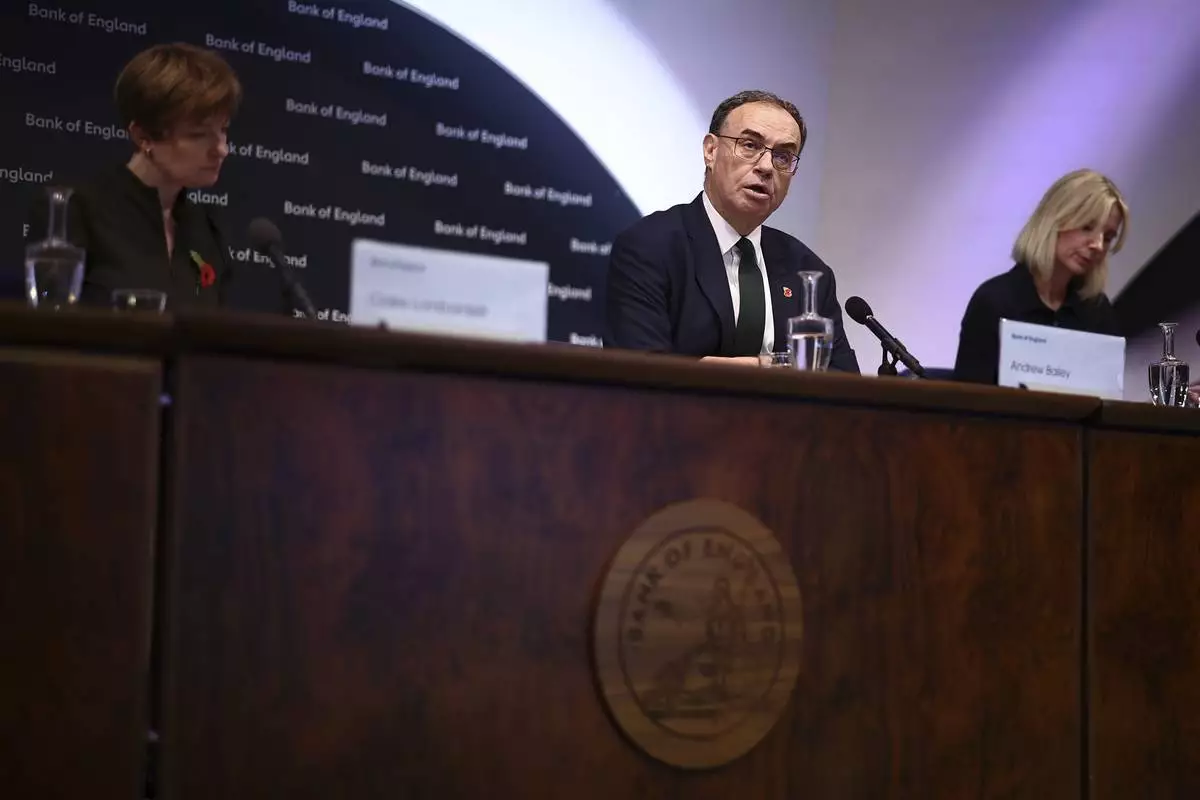LONDON (AP) — Inflation in the U.K. rose sharply to a six-month high in October and back above the rate targeted by rate-setters at the Bank of England, official figures showed Wednesday, an increase that is set to cement market expectations that there will be no further cuts in borrowing rates this year.
The Office for National Statistics said higher domestic energy bills pushed consumer price inflation up to 2.3% in the year to October from the three-year low of 1.7% recorded the previous month.
The increase, which was above forecasts for a more modest increase, took inflation above the bank's target rate of 2%.
Earlier this month, the bank increased its main interest rate by a quarter of a percentage point to 4.75% — the second in three months — after inflation fell to its lowest level since April 2021.
However, Bank Gov. Andrew Bailey cautioned that rates wouldn't be falling too fast over the coming months, partly because last week’s budget measures from the new Labour government would likely see prices rise by more than they would otherwise have done. Rate-setters will meet once more this year, on Dec. 19, by which time they will be armed with more monthly inflation reading.
Central banks worldwide dramatically increased borrowing costs from near zero during the coronavirus pandemic when prices started to shoot up, first as a result of supply chain issues and then because of Russia’s full-scale invasion of Ukraine which pushed up energy costs. As inflation rates have recently fallen from multidecade highs, the central banks have started cutting interest rates.

People hold umbrellas as they walk in front of the Bank of England, at the start of a week that is set to see the temperatures drop, in London, Monday, Nov. 18, 2024. (AP Photo/Alberto Pezzali)

Bank of England Governor Andrew Bailey speaks during the central bank's Monetary Policy Report press conference at the Bank of England, in London, Thursday, Nov. 7, 2024. (Henry Nicholls/Pool Photo via AP)
HONG KONG (AP) — Asian stocks were mostly lower on Tuesday, despite gains on Wall Street, as worries mounted over escalations in the Russia-Ukraine war.
U.S. futures edged higher while oil prices were little changed.
On Tuesday, Ukraine fired several American-supplied longer-range missiles into Russia, according to the official, marking the first such use in nearly 1,000 days of war. On the same day, Russian President Vladimir Putin formally lowered the threshold for Russia’s use of its nuclear weapons.
In Japan, the Nikkei 225 slipped 0.2% to 38,352.34 after the Finance Ministry reported the country recorded a trade deficit in October, for a fourth straight month. Exports rose 3.1% from a year earlier as a weak yen and the rising price of energy kept import costs high. A trade deficit occurs when the country is importing more goods and services than it is exporting.
Shares of Seven & i Holdings Co., the company that owns over 80,000 7-Eleven convenience stores worldwide, soared 8.4% on Wednesday after local media reported that the founding family plans to raise over 8 trillion yen ($51.66 billion) to take the company private within this financial year.
China's central bank announced it will keep its benchmark lending rates unchanged after it cut its one-year lending rate to 3.1% in October. Hong Kong’s Hang Seng edged 0.1% higher to 19,687.10, and the Shanghai Composite gained 0.1% to 3,979.15.
Australia’s S&P/ASX 200 dipped 0.6% to 8,326.30. South Korea’s Kospi added 0.4% to 2,482.29.
On Tuesday, the S&P 500 rose 0.4% to 5,916.98 after erasing an early drop of 0.7%. The Nasdaq composite also shook off an early loss to turn 1% higher to 18,987.47, while the Dow Jones Industrial Average slipped 0.3% to 43,268.94.
Nvidia’s 4.9% climb accounted for most of the index’s gain. The chip company’s stock rallied ahead of its profit report for the latest quarter, which is coming later Wednesday, and vaulted its gain for the year to nearly 197% thanks to the craze around artificial-intelligence technology.
The worries on the Ukraine-Russia conflict sent investors into U.S. Treasury bonds, which are seen as some of the world’s safest investments. The rise in their prices in turn lowered their yields, and the 10-year Treasury yield fell to 4.39% from 4.41% late Monday.
Gold also rose 0.6% and recovered some of the losses it sustained following Donald Trump’s victory in the U.S. presidential election, as investors herded into places traditionally considered safer during times of trouble.
Walmart climbed 3% after topping forecasts for both profit and revenue. The nation’s biggest retailer said it saw broad-based strength across its categories, including sales made both online and in stores. It also said it served more upper-income households, while raising its forecasts for sales and profit for the full year.
Lowe’s likewise delivered bigger profit and revenue for the latest quarter than analysts expected, but its stock nevertheless dropped 4.6%. A report in the morning said construction crews broke ground on fewer new homes last month than economists expected, and rival Home Depot slipped 0.9%.
Other big companies set to report their latest quarterly results this week include Target on Wednesday and Deere & Co. on Thursday.
In other dealings early Wednesday, benchmark U.S. crude oil edged 15 cents higher to $69.39 per barrel in electronic trading on the New York Mercantile Exchange.
Brent crude, the international standard, added 10 cents to $73.41 per barrel.
The dollar rose to 155.47 Japanese yen from 154.54 yen. The euro slipped to $1.0588 from $1.0598.

FILE - The morning sun shines on Wall Street in New York's Financial District on Tuesday, Nov. 19, 2024. (AP Photo/Peter Morgan)

Currency traders watch their computer monitors near the screens showing the Korea Composite Stock Price Index (KOSPI), left, the foreign exchange rate between U.S. dollar and South Korean won, center, and the Korean Securities Dealers Automated Quotations (KOSDAQ), at a foreign exchange dealing room in Seoul, South Korea, Wednesday, Nov. 20, 2024. (AP Photo/Lee Jin-man)













